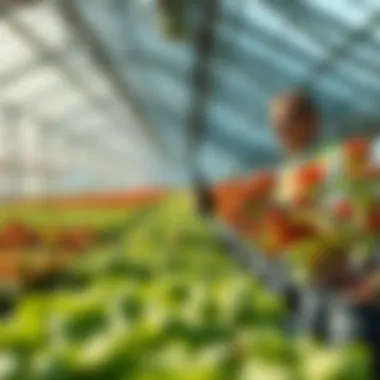Understanding Hydronic Greenhouse Heating Systems


Intro
In the world of agriculture, the right environment can spell the difference between a bountiful harvest and barren plots. One such method capturing attention in recent years is hydronic greenhouse heating. It's not merely about keeping plants warm; it's about engineered precision that ensures crops thrive in their optimal conditions.
Hydronic heating involves the use of water-filled pipes to distribute warmth effectively throughout a greenhouse. Unlike traditional heating methods, this system melds efficiency with controllability. As the complexities of climate change and energy costs intensify, modern horticulturists are increasingly leaning towards this approach, fostering an environment that is not only conducive for growth but also sustainable and resource-efficient.
To provide a well-rounded understanding of hydronic heating, it’s crucial to delve into various aspects including the principles behind it, the benefits it brings, and even the challenges faced during implementation. In the sections that follow, you will discover a wealth of information designed for both seasoned agricultural professionals and keen enthusiasts eager to embrace the latest advancements in greenhouse technology.
Prelude to Hydronic Greenhouse Heating
In the realm of agriculture, the term "hydronic heating" has gained traction, especially among those dedicated to greenhouse cultivation. The extended growing seasons and sustainable practices that hydronic systems facilitate have created a buzz. This article sheds light on the principles and practices involved, making it a valuable resource for farmers and enthusiasts looking to improve their operations through efficient heating methods.
Defining Hydronic Heating
At its core, hydronic heating refers to a system that uses heated water to provide warmth in various settings, including greenhouses. Unlike traditional heating solutions that often rely on air circulation, hydronic systems transfer heat through liquid, typically water, running through pipes. These systems can utilize different energy sources, like natural gas, electricity, or renewable options such as solar power, depending on the needs and resources of the grower.
Hydronic heating operates by circulating heated water through pipes embedded in the greenhouse structure. The warm water radiates heat more uniformly and efficiently than forced air systems, making it effective for nurturing sensitive plants. The use of water as a carrier of heat means that it can retain warmth longer, facilitating a more stable environment.
Key components of hydronic systems include:
- Boilers or heaters: These devices heat the water within the system.
- Piping network: This is where the warmed water travels to distribute the heat across the greenhouse.
- Thermostats and controls: Tools that allow growers to monitor and adjust the temperature for optimal plant growth.
Importance in Greenhouse Agriculture
The significance of hydronic heating in greenhouse agriculture cannot be overstated. As farmers face challenges such as fluctuating temperatures and climate change, hydronic heating offers various benefits that contribute to more resilient farming practices.
- Energy Efficiency: Using water for heat distribution is generally more energy-efficient compared to air systems. This efficiency can lead to lower energy costs over time.
- Consistent Temperature Control: Hydronic systems provide precise temperature regulation, which is crucial for sustaining plant health. Irregular temperatures can lead to stunted growth or crop failure. Therefore, achieving consistent warmth is vital for successful cultivation.
- Reduced Risk of Disease: By maintaining an even temperature, these systems can reduce risks related to overheating or cold spots, helping to prevent conditions that often promote disease.
- Flexibility in Design: Hydronic systems can be tailored to fit various greenhouse designs and sizes. This adaptability makes them a popular choice for both small-scale operations and large commercial farms.
- Integration with Renewable Energy: Many growers are now linking hydronic systems with renewable energy sources, such as solar panels, enabling sustainable operations while further cutting energy costs.
Hydronic heating not only promotes plant growth but also aligns with sustainable agricultural practices.
In summary, understanding hydronic greenhouse heating lays the groundwork for growers who wish to enhance their yield and efficiency. By exploring hydronic heating, agricultural professionals can navigate the intricacies of modern farming more adeptly.
Mechanics of Hydronic Systems
The mechanics of hydronic systems play a crucial role in the effectiveness and efficiency of greenhouse heating. Understanding the key principles and elements at play helps farmers and other agricultural enthusiasts design systems that are not only functional but also optimized for energy conservation and crop health. In this section, we will delve deep into the basic components that make up hydronic heating systems and explore their fluid dynamics. This knowledge is indispensable for anyone looking to harness the benefits of this technology in a greenhouse setting.
Basic Components Overview
To effectively set up a hydronic heating system, it’s vital to first familiarize oneself with its core components. Each part has a distinct role, and understanding these can simplify the overall design and operation of the system. The main components include:
- Heat Source: This is often a boiler or a heat pump, which produces hot water for circulation.
- Piping Network: The maze of pipes distributes heated water throughout the greenhouse, ensuring even temperature coverage. This network must be designed properly to minimize heat loss.
- Heat Distribution Elements: These can be radiators, surface heating systems, or other methods that help transfer heat to the air within the greenhouse.
- Controls and Thermostats: These ensure that the system operates at optimal temperatures, responding to changes in environmental conditions and crop requirements.
- Circulation Pump: It facilitates the movement of hot water within the system, ensuring that the warmth reaches all corners of the greenhouse without excessive energy use.
By understanding the functions of these elements, growers can make informed decisions when designing their systems or troubleshooting issues that arise.
Fluid Dynamics in Heating
Fluid dynamics is the backbone of any hydronic heating system. The way water flows through pipes and is distributed within the greenhouse influences not just efficiency, but also the health of the plants. Let’s break down some key aspects:
- Flow Rate: A steady, calculated flow rate is essential, as it affects how quickly heat is delivered to plants. If the water moves too quickly, it may not absorb enough heat; if it’s too slow, plants may suffer from inadequate warmth.
- Pipe Sizes: Different sizes affect pressure and flow. Using larger pipes can reduce resistance and improve flow rates, but they can also be more costly. Conversely, smaller pipes save on material but may lead to heat loss and uneven temperatures.
- Heat Exchange: The efficiency of heat transfer from water to air is critical. This is where the design of distribution elements comes into play. They should be strategically placed to create an optimal temperature gradient across the space.
- Thermal Stratification: Understanding that warm air rises can aid in the design. Proper placement of heating elements encourages even heat distribution, avoiding hot and cold zones that can hinder plant growth.


"Fluid dynamics not only dictates system efficiency but also directly influences plant vitality. A well-balanced system is key to thriving crops."
Farmers looking to create an effective hydronic heating setup must grasp these fluid mechanics closely. By implementing the right components and paying attention to the dynamics of heat transfer, growers can maximize the benefits of hydronic systems in their greenhouses. This understanding leads to better crop yields and more sustainable practices, which is the ultimate goal of any dedicated greenhouse operator.
Types of Hydronic Systems
In the world of greenhouse heating, understanding the different types of hydronic systems is fundamental. Each system has its own set of benefits and design considerations, which affects how well it functions for specific agricultural needs. Choosing the right type can lead to better energy efficiency and optimal temperature regulation. Therefore, evaluating the strengths and limitations of each system is essential for any greenhouse operator aiming to thrive in their farming endeavors.
Conventional Hydronic Systems
Conventional hydronic systems are the most widely used in greenhouses, relying on a network of pipes and a centralized boiler for heat distribution. These systems work on a straightforward principle: hot water is circulated through pipes that run beneath plant beds or along the greenhouse perimeter, providing a consistent heat source. The ability to maintain uniform temperatures is one of the major advantages of this system.
A few key characteristics define conventional systems:
- Boiler Types: Conventional systems may use gas, oil, or electric boilers, each with varying efficiencies and ecological impacts. Choosing the right boiler can greatly influence operational costs.
- Heat Exchangers: Heat exchangers play a crucial role in transferring heat from the boiler to the water circulating in the system. Their design affects efficiency; hence, selecting an effective model can boost overall performance.
- Zoning: Using multiple zones allows for tailored heating solutions in different sections of the greenhouse. This can be particularly important when cultivating various plants with different heating needs.
However, the initial investment and ongoing maintenance can be significant drawbacks. Components may wear down over time, leading to costly repairs. Operators need to weigh these factors carefully, keeping in mind their unique budgetary constraints and sustainability goals.
A well-designed conventional hydronic heating system allows for precise temperature control, enhancing plant growth and productivity while potentially lowering heating costs in the long term.
Solar-Assisted Hydronic Heating
As the spotlight shines on sustainable practices in agriculture, solar-assisted hydronic heating is emerging as a viable option worth considering. Leveraging solar energy, this system supplements traditional heating methods with renewable resources. By reducing dependency on fossil fuels, it offers both economic and environmental benefits.
Here are some important aspects:
- Integration with Solar Panels: Typically, solar panels collect heat during sunny days, which is then transferred to the hydronic system. This complementary heating method helps cut energy costs considerably, especially in regions with ample sunlight.
- Increased Efficiency: The combination of solar energy with existing heating methods creates a more efficient overall system. The reliance on free solar power reduces energy bills substantially and contributes positively to carbon footprint reduction.
- Seasonal Adjustments: Solar-assisted systems allow for adjustments based on seasonal needs. For instance, during hotter months, reliance on solar energy can take precedence over traditional heating, thereby minimizing energy consumption.
Adopting solar-assisted hydronic heating does present challenges. The setup may require higher initial capital investment and careful design to maximize efficiency. Additionally, variable weather conditions can limit the solar energy captured on cloudy days. Ongoing maintenance of the solar equipment is crucial yet might involve inconvenience.
In summary, understanding the intricacies of conventional and solar-assisted hydronic systems enables agricultural professionals to devise more efficient, ecologically sound practices. This informed approach can not only sustain but enhance productivity within greenhouse settings.
Design Considerations
Designing an effective hydronic heating system for greenhouses is not a light task—it requires a solid understanding of several key factors. Making thoughtful choices in system design can lead to greater efficiency, lower running costs, and enhanced crop yields. Proper design considerations encompass sizing the system and ensuring the layout and installation practices are spot on. Each of these elements contributes to the overall effectiveness and longevity of the heating system.
Sizing the System
When it comes to hydronic heating, sizing the system correctly is crucial. An undersized system will struggle to deliver adequate heat, leaving plants vulnerable to temperatures that could stunt growth. Conversely, an oversized system can lead to excessive energy use and higher operational costs. Achieving the right balance is no small feat; it requires a deep dive into the specifics of the greenhouse environment.
Here are some essential points to consider when sizing a hydronic heating system:
- Greenhouse dimensions: Measure the length, width, and height to determine the overall area that needs heating.
- Plant types: Different crops have varying thermal needs. Knowing what you're growing helps in calculating proper heating requirements.
- Insulation quality: Assessing the insulation in the greenhouse is vital; better insulation retains heat more efficiently.
- Location and climate: Understanding local weather conditions is key. Colder climates demand more robust systems to maintain temperature.
- Desired temperature range: Define the optimal temperature required for the plants, which is essential to establish how much heat is needed.
Calculating these factors often involves utilizing heating load calculations or consulting experts. An accurately sized system will enable consistent growth and reduce waste, resulting in a more economical operation.
Layout and Installation Best Practices
Once the system is properly sized, the focus shifts to the layout and installation practices. The layout of pipes, radiators, or heating mats needs careful consideration to ensure even distribution of heat throughout the greenhouse. Thoughtful installation can enhance efficiency and improve crop health.
When planning your layout, keep the following best practices in mind:


- Circulation: Ensure that the hot water is circulating evenly throughout the greenhouse. This avoids hotspots and cold spots that can affect plant health.
- Pipe positioning: Arrange pipes strategically. For example, placing them along benches or underneath growing areas can maximize heat distribution to the plants.
- Elevation considerations: When installing radiators or heating mats, consider installing them at optimal heights to disperse heat effectively.
- Accessibility for maintenance: Plan your layout so that all components of the system, like pumps, valves, and sensors, are easily accessible for maintenance and troubleshooting.
- Integration with other systems: If using renewable energy sources like solar, consider how they will integrate with your hydronic heating system to maximize sustainability.
Ensuring your installation adheres to these practices not only improves efficiency but also extends the longevity of the entire system. By keeping the heating system well-integrated, effective, and user-friendly, you set a solid foundation for successful greenhouse operations.
"Proper design and implementation of hydronic heating can transform a greenhouse into a powerful tool for agricultural success."
Benefits of Hydronic Heating
Hydronic heating, often overshadowed by other heating methods, offers a bouquet of benefits, especially in greenhouse settings. As agricultural practices evolve and energy costs continue to rise, the significance of understanding these advantages cannot be overstated. This section delves into the compelling reasons hydronic systems are gaining traction among farmers and agricultural enthusiasts alike. A well-designed hydronic heating system not only supports healthy plant growth but also directly impacts operational expenses and sustainability efforts.
Energy Efficiency Advantages
One of the standout features of hydronic heating systems is their energy efficiency. Unlike conventional heating methods, which rely on forced air that can lead to significant heat loss, hydronic systems operate on a simpler principle: water conducts heat more effectively than air. A few significant points to highlight include:
- Lower Energy Consumption: By utilizing hot water as a heating medium, hydronic systems generally operate at lower temperatures compared to traditional heating methods, reducing energy use significantly.
- Zoned Heating: These systems offer the flexibility of zoning, enabling growers to heat specific sections of a greenhouse based on the needs of particular crops. This targeted approach minimizes wastage and maximizes efficiency.
- Reduced Operating Costs: In the long run, many growers find that investing in a hydronic system saves them a hefty sum on their utility bills. The decreased energy consumption combined with less reliance on fossil fuels makes it a wise financial move.
"Hydronic systems stand as a bright beacon for anyone looking to strike a balance between operational efficiency and environmental consciousness."
Consistent Temperature Control
Another fundamental advantage is consistent temperature control. Greenhouses thrive on the delicate balance of temperature regulation, and hydronic heating systems are up for the task. Here’s how they achieve this vital requirement:
- Optimal Growth Conditions: Maintaining a stable temperature helps in protecting delicate seedlings and mature plants alike. Inconsistent heat can lead to stress and adversely affect crop yields.
- Illumination of Cold Spots: One common grievance in many greenhouse settings is the prevalence of cold spots. Hydronic systems distribute heat more uniformly throughout the space, effectively addressing these variations and ensuring a comfortable environment for all plants.
- Greater Control: Modern hydronic systems come equipped with sophisticated controls that allow growers to fine-tune their heating strategy in response to external weather changes. This adaptability can enhance plant health and vigor substantially.
The benefits of hydronic heating extend beyond mere numbers. They encapsulate a philosophy of cultivating plants in a way that respects both financial constraints and environmental responsibilities. As one considers these advantages, the value of hydronic systems in greenhouse agriculture becomes unmistakable.
Challenges in Implementation
Implementing a hydronic heating system in greenhouses comes with its own set of challenges. These can be pivotal for farmers looking to enhance their crop yield and energy efficiency. Understanding these hurdles not only ensures a smoother transition into adopting this heating method but also prepares agriculturalists for the practicalities of managing such systems.
Common Technical Issues
One of the main technical challenges that cultivators face when setting up hydronic heating systems is related to their fluid dynamics. These systems depend on the efficient circulation of heated water through pipes to provide even warmth. If there are leaks in the pipework or if the system is not properly calibrated, it can lead to cold spots in the greenhouse where crops might suffer from inadequate warmth. It is common to see issues arising from:
- Air trapped in the system: If air pockets form, they hinder the flow of water, leading to uneven heating.
- Pump failure: If the pump malfunctions, circulation stops, risking plant health, especially in colder months.
- Sensor inaccuracies: Thermostats or sensors can misread temperatures, resulting in improper heating decisions.
Regular maintenance and monitoring are essential for keeping these technical issues at bay. Using quality materials and employing experienced technicians during installation phases can mitigate many of these pitfalls.
Costs and Budgeting Constraints
When it comes to costs, implementing a hydronic heating system can range from moderate to steep, depending on a myriad of factors. Initial setup costs often include not just the purchase of heating elements, but also plumbing, insulation, and control units that can add up quickly. Farmers must wrestle with:
- Upfront investment: The initial financial outlay might deter some, especially small-scale farmers or those new to hydronic systems.
- Long-term operational costs: While hydronic systems can save energy costs over time, the reality of maintenance and repairs can sometimes hit the wallet hard.
- Budget overruns: Unexpected issues during installation may require additional funding, which can disrupt financial balance.
But all is not lost. Some farmers have found funding through government grants and environmental programs aimed at promoting sustainable agriculture. Exploring options like these can ease the financial burden and make the transition to hydronic heating more feasible.
"Investing in hydronic systems can be daunting, but the potential return on investment is significant, especially when looking at energy savings over time."
Case Studies and Practical Applications
Exploring case studies within hydronic greenhouse heating provides invaluable insights into its real-world applications. These studies offer practical examples of how specific configurations, designs, and technologies can be successfully executed, showcasing the adaptability of hydronic systems in varying conditions and environments. Let's delve into examples and comparative analyses that highlight the efficacy and versatility of hydronic heating, essential for anyone in the field of agriculture.


Successful Hydronic Greenhouses
In various regions, hydronic systems have earned their place in modern greenhouse operations. A notable instance is the Danforth Greenhouse in New Jersey, where a system designed with precision maintains optimal temperatures for a variety of crops. Utilizing a mix of water sourced directly from a nearby pond and a closed-loop hydronic setup, the greenhouse reduces energy costs significantly while providing a stable environment that enhances plant growth.
The Greenhouse at Colorado State University serves as another prime example. Here, innovation blends seamlessly with education. The institution implemented a hydronic heating system using solar panels to heat water, allowing for substantial reductions in fossil fuel reliance. The research conducted not only showcases energy-saving benefits but also positions the university as a leader in integrating sustainable practices into agricultural education.
These successful implementations underscore several key elements:
- Cost Efficiency: Both greenhouses demonstrate marked reductions in operating costs through energy-conscious designs.
- Adaptability: The systems can be customized based on local climate variations, making them suitable for diverse environments.
- Crop Health: Enhanced control over temperature and humidity has led to improved plant health and yield quality.
Comparative Analysis with Other Heating Systems
When evaluating hydronic heating against other systems, such as forced air or electric heating, the benefits become strikingly clear. While forced air systems may offer quick temperature adjustments, they often result in uneven heating and are more prone to creating drafts. Hydronic systems, on the other hand, provide steady, uniform heat distribution, which is crucial for maintaining crop health.
Consider the Greenhouse Technology Study conducted by the USDA. The study measured efficiency and cost-effectiveness between different heating systems over a year. Here’s a breakdown of some insightful findings:
- Energy Consumption: Hydronic systems used approximately 30% less energy compared to electric heating solutions, illustrating economic advantages.
- Temperature Control: Temperature fluctuations were reduced by over 50% with hydronic systems, ensuring crops receive consistent warmth.
- Operational Longevity: Studies show that hydronic systems generally require less maintenance than forced air systems, leading to fewer downtime interruptions.
"The adoption of hydronic heating systems in greenhouse environments represents a transformative step towards sustainable agriculture, emphasizing efficiency and crop quality."
Overall, comparative analyses reveal the superior effectiveness and sustainability of hydronic heating. They not only support robust plant life but also align with the growing demand for eco-friendly agricultural practices.
Future of Hydronic Heating in Agriculture
The future of hydronic heating within the realm of agriculture holds significant promise. As climate conditions become increasingly erratic, finding reliable and effective heating systems is more vital than ever for greenhouse operations. Hydronic systems stand out not only for their efficiency but also through their adaptability to new technologies and practices that align with sustainable agriculture.
Innovations and Technology Advances
In the pursuit of more effective hydronic systems, recent advancements in technology play a pivotal role. Several key innovations have transformed the hydronic heating landscape:
- Smart Control Systems: Integration of IoT (Internet of Things) in hydronic systems has ushered in a new era of automation. Farmers can now control their heating units remotely, adjusting temperatures based on real-time data from sensors placed throughout the greenhouse. This ensures optimal plant growth conditions while conserving energy.
- Advanced Heat Exchangers: New designs in heat exchangers have improved heat transfer efficiency and reduced energy loss. These technologies can deliver warmth more effectively throughout the greenhouse, making each BTU of energy spent far more effective than in traditional systems.
- Modular Designs: Now, hydronic systems can be built modularly, adapting to a variety of greenhouse sizes and layouts. This flexibility allows for easier upgrades or expansions in the heating system as new technologies become available or as the farmer’s needs evolve.
- Hybrid Systems: A growing trend is the employment of hybrid systems that combine multiple energy sources. For example, solar panels working in conjunction with a hydronic heating system provide a cleaner approach to energy sourcing—significantly cutting down energy costs.
These innovations not only create efficiencies but also cultivate a deeper reliance on renewable energy, aligning agribusinesses with global trends toward sustainability.
Sustainability and Environmental Impact
The environmental implications of adopting hydronic heating systems in agriculture are profound. As the agriculture sector faces increasing scrutiny over its carbon footprint, shifting towards more sustainable systems is crucial. Hydronic heating offers several environmental benefits:
- Energy Efficiency: Hydronic systems use water as a heat transfer medium which typically requires less energy than air-based systems. This can lead to lower utility bills and reduced fossil fuel consumption, which aligns with broader goals of decreasing greenhouse gas emissions.
- Lower Carbon Footprint: By employing renewable energy sources such as solar or biomass in conjunction with hydronic systems, farmers can significantly reduce their reliance on nonrenewable resources. It helps in making the agricultural sector as a whole more sustainable.
- Efficient Resource Use: In hydroponic systems, the use of hydronic heating can lead to higher crop yields while using less water. Moreover, a well-designed hydronic system minimizes resource wastage thereby leading to a more efficient greenhouse operation.
- Soil Preservation: Maintaining consistent soil temperatures not only boosts crop health but also reduces soil degradation—a critical aspect of sustainable farming practices. Hydronic heating can ensure that soil remains warm enough for microbial life to thrive, thus benefiting overall plant health.
"Sustainability in agriculture is no longer a luxury; it's a necessity."
The successful integration of hydronic heating systems represents a major step towards sustainable farming, offering solutions that minimize environmental impact while improving agricultural productivity. The future of hydronic heating is not merely about technology; it is about forging a resilient and sustainable agriculture that secures food production for generations to come.
Culmination
In synthesizing the insights gathered from this exploration of hydronic greenhouse heating systems, its significance in modern agriculture stands out distinctly. As farmers and agricultural enthusiasts seek efficient and sustainable methods to optimize their production, hydronic systems present a viable solution that marries energy conservation with effective crop heating.
Recapping the Hydronic Heating System
To recap, hydronic heating operates on the principle of circulating heated water through tubing laid beneath plant beds or within greenhouse structures. This method not only provides a uniform heat distribution but also minimizes energy waste. By understanding the nuances of the core components—like pumps, pipes, and heat sources—individuals can tailor systems to specific greenhouse designs and crop requirements. This information underscores the adaptability of hydronic systems in various climates, ensuring that out-of-season crops can flourish despite external conditions.
Call for Ongoing Research
Looking ahead, there is a pressing need for ongoing research in the realm of hydronic heating technology. With the rapid advent of climate change and the quest for carbon-neutral farming practices, innovations such as smart sensors, renewable energy integration, and automated controls become imperative. These advancements could significantly enhance the efficiency and environmental footprint of hydronic systems, making them even more appealing to the agricultural community. By encouraging dialogue among researchers, engineers, and practitioners, we can foster an ecosystem that champions sustainability and innovation in greenhouse agriculture.
As this sector evolves, so too must our approach to research and implementation. Collaborations between scientific institutions, tech companies, and farmers should be actively promoted to catalyze further advancements in this promising field. This focus will not only improve present practices but also lay a solid foundation for the future of food production in sustainable environments.















